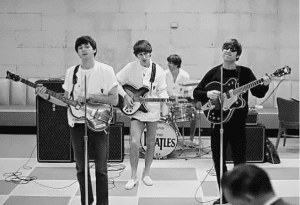Paul Simon Explains His Guitar Picking Style

via The Howard Stern Show / Youtube
Classic rock icon Paul Simon has recently dropped by The Howard Stern Show with his signature Martin guitar and demonstrated how he first learned to play the guitar and how it evolved from there.
The acclaimed singer-songwriter displayed impeccable acoustic guitar skills in the talk show as he entertained Howard with effortless guitar picking, which his father taught him when he was 13 years old.
“My father taught me when I really want to learn to play this song, “Earth Angel”,” Simon said as he plucked the intro to the song by American doo-wop group The Penguins.
Learning the guitar
When Stern brought up his signature picking style used in his popular songs, Simon told the host that the flat pick was his first choice of style. This style was what his father taught him as he learned ”Earth Angel”.
“He taught me those chords and they fit, maybe, ninety percent of the songs that I first heard,” the “Sound of Silence” star shared.
When Howard once again brought up finger-picking, Simon exhibited what was called Travis picking, a fingerstyle technique named after country and western singer and guitarist Merle Travis.
Paul Simon playing acoustic guitar. pic.twitter.com/5C6oxN4cFj
— peterkidder (@peterkidder) October 29, 2018
“The thing with this kind of picking is the thumb is always moving, and the other fingers go [strums guitar],” Simon explained.
The acoustic guitar legend jokingly said that you might turn heads if you bring this finger-picking style to Sun Records, an independent label known as the first to sign Elvis Presley, Johnny Cash, and Roy Orbison.
Then Simon effortlessly strums and sings the intros to Junior Parker’s “Mystery Train” and their own classic hit “The Boxer”.
‘The guitar is like the universe’
When asked by Howard when did he realize he was a really good guitar player, the classic rock legend wisely shared, “I am a good guitar player, but the guitar is like the universe. You can never come to the end of what you can learn from it.”
“You still love it,” Howard declared and asked, “I don’t know what your day is like but do you get up and like ‘I really wanna play the guitar today’?”
Simon pondered and related that it’s “akin to that feeling”. “If I don’t play, I’m uncomfortable… it’s not like I play every day and I practice. I’m not practicing, I’m just fooling around with stuff,” the 81-year-old music icon added.
Paul Simon chatted with Howard Stern on the @DailySternShow on various topics from #SimonAndGarfunkel, Monterey Pop Festival, to his latest release, “Seven Psalms”.
On the duo’s breakup: “It wasn’t Artie’s fault,” and the making of the ‘Bridge’ album.
🎞 https://t.co/1MHvvUL0eA pic.twitter.com/yyLcmeIRSt— Simon & Garfunkel (@SimonGarfunkel) September 23, 2023
Paul Simon made his debut this month on The Howard Stern Show, engaging in a comprehensive interview a few months after the release of his most recent project, Seven Psalms.
During the conversation with Howard, Simon revisited the disbandment of Simon & Garfunkel, shared the story of how he encountered his wife Edie Brickell at Saturday Night Live, displayed Travis picking, and provided insight into the creative process behind crafting several of his timeless hits, among them “Cecilia” and “50 Ways To Leave Your Lover”.
Beyond the sound of silence
Simon is one-half of the popular acoustic duo Simon & Garfunkel who won recognition for their blend of folk and rock, producing hits such as “The Sound of Silence”, “Mrs. Robinson”, “America” and “The Boxer”, which served as a soundtrack to the counterculture movement.
It was not all success for the duo though, as they previously disbanded after the disappointing response to their debut album, Wednesday Morning, 3 A.M., which featured their first major hit “The Sound of Silence”.
Following this failure, Paul made a pivotal move to London in 1965, where he discovered the burgeoning folk scene of the mid-60s in full swing.
Are Paul Simon and Art Garfunkel one of the BEST duos in music HISTORY? 👇🏻 pic.twitter.com/25C9JUnQ7j
— 🎸 Rock History 🎸 (@historyrock_) September 22, 2023
The subsequent release of the amplified, electric version of “The Sound of Silence” marked the turning point in his career, leading to a more successful 14-year collaboration with his childhood friend Art Garfunkel and eventually propelling him into a successful solo career.
Simon’s artistic trajectory has always been marked by eclecticism, as he swiftly departed from folk to evolve into a prominent pop/rock songwriter, drawing inspiration from a wide array of influences.
With his clever lyrics, robust melodies, and lush vocal harmonies, he demonstrated both a remarkable inventiveness in chord progressions and an underappreciated talent as a guitarist.














